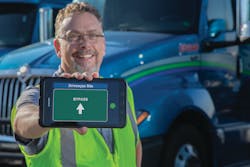How technology has transformed Mesilla Valley Transportation's fleet
Royal Jones, owner of Mesilla Valley Transportation (MVT), has always been a big believer in how technology can transform and improve trucking fleets. Back in the 1980s, Jones wanted his own wind tunnel to test aerodynamic technology on MVT trucks. But a wind tunnel was too expensive for the young trucking company at the time. Instead, he just found a big hill in New Mexico.
Jones and his staff started coasting “the trucks down the hill, and that was what taught them a lot about some of the benefits of aerodynamics—and because they were just coasting down this hill, it gave them a consistent experience for the aerodynamics,” Mike Kelley, who has been MVT’s chief technology officer since 2001, told FleetOwner.
Looking for that technological edge has been part of the fabric of Mesilla Valley for nearly 40 years. The carrier was an early adopter of aerodynamic technologies such as trailer skirts and tails and super-single tires. The mpg savings that came with these advances helped the fleet grow to more than 1,500 power units. (It sits at No. 82 on the 2020 FleetOwner For-Hire 500.)
“We’re on a constant mission to improve,” Kelley said. “We look at inefficiencies or challenges and utilize technology to improve our processes within our company and within the truck. On the truck itself, owner Royal Jones, his design team, and procurement managers for MVT look at technology to improve fleet performance.”
By the late 1980s, Mesilla Valley was averaging more than 7 mpg, a statistic that made many other fleet owners skeptical, Kelley noted. But these days, thanks to more technology and focus, MVT is averaging 9 mpg. The company focuses on the small gains that lead to big savings.
“Royal can tell you how just one-tenth of an mpg improvement can impact our bottom line per day and per year, even factoring in the cost of fuel. It’s what’s led us to be the leader in fuel economy,” Kelley said.
The latest MVT implementation was Platform Science, which the fleet coupled with Drivewyze PreClear. “Through Platform Science, we’re able to leverage our expertise and the things we want tracked and use the cloud to make micro changes quickly through Platform Science,” Kelley explained. “We were able to activate Drivewyze PreClear immediately with the platform. It was as simple as saying ‘turn it on please.’”
Drivewyze’s transformation in weigh station bypass—moving from transponder-based technology to one that uses cellular data—has made a huge impact on the fleet. The technology also gives drivers a warning two miles before the truck gets there, which Kelley said has cut down on MVT drivers missing weigh stations.
“We’ve gone from something that gave us a green light or red light for bypasses to one that gives us not only bypasses, but information and data on our performance and how weigh station bypass benefits our company,” he said. “Drivewyze is a technology company, and we value them as a partner, not as a vendor. Like us, they leverage their technology, and they think out of the box. We like that.”
Because PreClear doesn’t use transponders, reassigned drivers don’t need to worry about remembering to transfer a transponder to a new vehicle. And the data back from Drivewyze shows that MVT drivers are averaging 15 bypasses per month. “That saved us a tremendous amount in time and fuel, all documented,” Kelley said. “The time savings alone—with the advent of ELDs and the clock ticking on drivers—makes bypass even more important.”
Kelley said he’s in the process of turning on Drivewyze Safety Notifications, which provides alerts on high rollover areas, low bridges, and mountain alerts (steep grades, brake check areas, and runaway ramps).
“It’s more about making life easier for the drivers,” Kelley added, noting that what’s good for the drivers can be great for the fleet.
About the Author
Josh Fisher
Editor-in-Chief
Editor-in-Chief Josh Fisher has been with FleetOwner since 2017. He covers everything from modern fleet management to operational efficiency, artificial intelligence, autonomous trucking, alternative fuels and powertrains, regulations, and emerging transportation technology. Based in Maryland, he writes the Lane Shift Ahead column about the changing North American transportation landscape.


